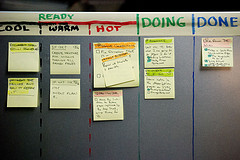 Have you ever noticed that some people avoid the spotlight? That is, they like to work on low-key projects that don’t get a lot of corporate attention. I’m not in any way suggesting that they don’t work hard. They simply don’t like drawing attention to themselves.
Have you ever noticed that some people avoid the spotlight? That is, they like to work on low-key projects that don’t get a lot of corporate attention. I’m not in any way suggesting that they don’t work hard. They simply don’t like drawing attention to themselves.
Along comes an agile development approach using Scrum, Kanban, XP or Lean techniques and life changes. Suddenly, daily meetings, business involvement, and self-organization are thrust upon them. There’s no way to avoid the spotlight any more. It’s no wonder they don’t like agile software development!
This is precisely why we talk about agile development requiring a cultural shift. It’s not just a new technique for delivering software. Not everyone will succeed in an agile development shop just like not everyone succeeds in a waterfall shop. In the end, whether you succeed or fail is entirely up to you.
Think about it differently.
Scrum techniques such as splitting epics into stories, dividing stories into tasks, estimating tasks, getting to done, and meeting commitments are traits that every company wants in its employees. Whether your Scrum team succeeds or fails, you will be developing skills and experience that will reward you along your chosen career path.
While there is a lot of emphasis on the values expressed in the Agile Manifesto, enterprise companies don’t care. If your company has a set of corporate values — most enterprise firms do — they will trump agile values every time. Companies are focused on revenues and profits. They need all of us to meet our goals, keep our commitments, and support one another — skills we all need to master.
Let me tell you a story.
Many years ago, I worked at a small firm that was seeking ISO 9001 certification. They manufactured touch screens and touch pads. Being ISO 9001 certified was a prestigious accomplishment that many companies were eager to achieve at the time.
We hired a consultant with expertise in this area to help us prepare for the certification process. The most profound and useful advice he gave us was simply this — “Say what you do and do what you say.”
In other words, don’t get caught up in all the details around “best practices”, “process improvements”, and “operating efficiencies.” Simply document what you do and do it. We achieved ISO 9001 certification by following that advice.
Take the advice.
My advice to anyone who dislikes the development approach they are being asked to follow is to let others handle the process details. You need to be clear on your role and your commitments. Armed with that information — Say what you do and do what you say. That’s all any reasonable person can expect from you.
That advice — Say what you do and do what you say — encapsulates the essence of Kanban too. Start with what you do today. Don’t make value judgments. Just lay it out on the Kanban board and track it. Use the visualization to guide the team in improving the process. It really works!
One of the great features of any agile approach to software development is the ability to change the approach. Yes, any team member can contribute to changing how the software is delivered. Take advantage of it. Speak up. Make suggestions. Change is good.
